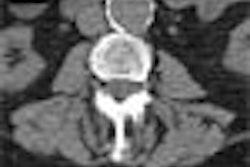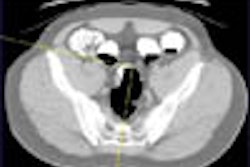You're a radiologist, you're cool, you think you can handle a virtual colonoscopy practice. All you need is a little help from someone who knows. You might ask Dr. Matthew Barish, assistant professor of radiology at Boston Medical Center's virtual colonoscopy center, and director of the 3-D and image processing center at Brigham and Women's Hospital, also in Boston. He's got hands-on experience.
In a talk at the April International Symposium of Virtual Colonoscopy in Boston, Barish began with a few assumptions: one, that third-party payors have agreed to limited reimbursement of virtual colonoscopy, and two, that the procedure is ready for routine clinical practice. Both assumptions are on the early side.
But someone's got to get the ball in the air, and let's say it's you. Start by recruiting asymptomatic patients with a low-to-moderate risk of colorectal cancer. The right patients are out there, Barish said, and they're ready for a new exam.
"Why start a (VC) program now? It fulfills patient need for an alternative test today," he said. "These are patients who do not want colonoscopy or (double-contrast) barium enema (DCBE). And this is clearly a recent patient demand. We currently accept that it's better than DCBE, and there are also two other reasons we simply can't ignore. They are the increase in CT scanner utilization, and the profit motive that is driving the current utilization in the practice of virtual colonoscopy."
Six essential elements are needed to begin a screening program, he said: patient recruitment, a CT scanner, clinical expertise in VC, a workstation, reporting and follow-up mechanisms.
Patient recruitment
The best target market consists of patients who have just emerged from failed colonoscopy. They're prepped and air-filled, they're gastroenterologist-referred, and they've got few other choices but DCBE. Plus, the radiologist can start to build a relationship with the gastroenterologist. Make sure to find out which colon segments didn't fail colonoscopy, Barish said. These sections can serve as a control for the radiologist, who can practice finding whatever the gastroenterologist found.
The next group consists of previously failed colonoscopy patients. Again, there's no real alternative but DCBE, and once again you'll have an opportunity to build trust with the gastroenterologist. However, these are likely to be tough cases: tortuous or collapsed colons, sigmoid diverticulosis and the like, and they can be very time-consuming for the radiologist, Barish said.
Referrals from primary care physicians and gastroenterologists constitute the third group of patients, who prefer VC or refuse traditional methods. With this group, the traditional referral and follow-up patterns are maintained.
The last group consists of self-referred patients. The good thing is that they want VC; the drawback is that their treatment sets up an atypical relationship between the radiologist and the patient.
"I realize this is similar to the mammography paradigm, but it is somewhat atypical for our specialty," Barish said. "It places the burden of follow-up on the radiologist, and there are many reporting and medico-legal issues that haven't been worked out ... although I do realize that (self-referred) patients are probably the largest group of patients out there, and that this (procedure) will be performed."
Equipment
You'll need a spiral CT scanner, of course, single- or multislice (MDCT). Electron-beam CT scanners (EBCT) have been used, but have not been evaluated in controlled studies, Barish said. As for MDCT, the more detector rows the merrier: they contribute to better accuracy, higher throughput, and fewer motion artifacts. But MDCT also means more slices to review, more archive space, higher costs.
Digital image review is required for VC, and you might get by with cine axial review. But without 3-D for problem solving, there will be times when it's impossible to distinguish a fold from a polyp, Barish said.
The optimal workstation will give you simultaneous prone and supine imaging, fully integrated 2-D and 3-D, and perhaps a third "novel" viewing mode. You could also think about structured reporting, computer-aided detection (CAD), and integration with a RIS attached to a database that could handle follow-up, like in mammography.
"The problem is, this workstation doesn't exist," he said. There is no integrated RIS and no FDA-approved CAD scheme for colonoscopy, though systems are currently in development. "I will say that all of the vendors here presenting workstations are capable of performing virtual colonoscopy," Barish said.
Training and technique
Training is important. Radiologists need to be able to judge the adequacy of the prep, hand out questionnaires, and be willing to ask patients about the character of their last bowel movement. Many incomplete VC studies can be eliminated by sending patients with solid stool or incomplete prep home to reprep and return the next day, Barish said. Technologists should be trained in rectal tube insertion, and in monitoring insufflation or patient self-insufflation.
"They need to understand the (acquisition) technique factors that are necessary for different patient populations, by looking at the patient's body habitus to determine the appropriate mAs and collimation and pitch," Barish said.
Using thinner slices increases spatial resolution and probably sensitivity, he said. At the same time, thinner slices mean a higher radiation dose, and coincidentally, longer reading times and more slices to examine. MAs can be lowered to compensate, but lesion conspicuity and extracolonic findings will be reduced.
Barish recommends 2-3 mm collimation, 60% reconstruction index, and "the lowest mAs sufficient to visualize colonic mucosa and detect lesions, but not necessarily characterization of parenchymal lesions. And this is somewhere in the range of 70-120 mAs."
Radiologists should have an adequate number of review cases under their belts before they begin to see patients, he said.
Reporting
There is a strong need to define a minimum polyp size to report and standardize reporting, Barish said. The answer directly affects specificity, but as yet there's been no clear consensus on what the number should be. Reporting too-small polyps leads to unnecessary colonoscopies, higher costs, and increased risk.
Proffering an example but not necessarily an endorsement, Barish said radiologists might decide to report only those polyps larger than 5 mm, and recommend polypectomy only for polyps 1 cm and larger -- with possible variations for age and comorbid conditions.
"I think it's important that we come up with some consensus eventually that allows us to do this and feel that we have some science to back us up," he said.
Administration
With regard to follow-up, the radiologist will ultimately be responsible for following up the patient in whom a lesion is found, Barish said. As a result, mammography-style databases that allow for direct reporting, reminder letters, and follow-up will be essential.
Billing questions remain largely unanswered, Barish said. For example, will insurance pay for virtual colonoscopy after failed colonoscopy? Will insurance cover physician-referred patients for screening virtual colonoscopy?
"All I can report is my own experience," he said. "There's a wide variation among insurance carriers (regarding) what they will cover, for what indications, and for what patients."
By Eric BarnesAuntMinnie.com staff writer
June 4, 2002
Copyright © 2002 AuntMinnie.com




















